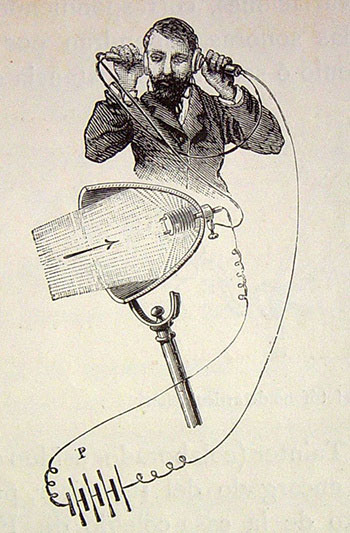Optical phone - device that transmits sound using light
Inventor Alexander Graham Bell had high hopes for optical telephones, envisioning that wireless communications would replace the tangled network of telephone wires.
Today, the telephone is often considered the greatest invention of Alexander Graham Bell (1847 - 1922). However, Bell disagrees with this. He once described the invention of the optical telephone or photophone - a device that transmits sound using light - as the greatest achievement of his life.

Illustration of the transmitter of an optical phone. (Photo: Amusing Planet).
In 1878, while on honeymoon in Europe with his wife, Bell read a study by Robert Sabine, published in the journal Nature , about the newly discovered property of selenium, which is that its resistance changes when affected by light. In his experiments, Sabine used measuring instruments to examine the effects of light on selenium rods connected in a circuit to the battery. "The slightest shading or other fluctuation in light intensity led to a significant change in the electromotive force of the two objects ," Sabine wrote.
Sabine thought it might be possible to use selenium as one of the elements in a wet Galvanic battery, but Bell found a more practical application. According to Bell, if he added a phone receiver to the same circuit, he would hear things that Sabine could only see.
Bell hired Charles Sumner Tainter, a musical instrument maker, and together they created a working optical telephone in the laboratory by attaching a metal grid to a screen, with the light beam interrupted. due to the movement of the grids in response to speech. As the modulated light beam hit the selenium receiver, Bell could clearly hear Tainter singing through his headphones.
On April 1, 1880, Bell and Tainter successfully communicated at a distance of about 79 m. A few months later, on June 21, they continued to communicate clearly at a distance of 213 m using sunlight as a light source. Tainter stood on the roof of Franklin and talked to Bell, who was standing in the laboratory. Bell then signaled Tainter by waving his hat from the window.

Illustration of the receiver of an optical phone. (Photo: Amusing Planet)
Bell hoped his new optical phone invention could be used on offshore vessels. He also envisioned that wireless communications would replace the tangled network of telephone wires that were increasingly springing up along bustling city streets.
"We will be able to talk using light at any visible distance without any wires. In general science, optical telephony will lead to discoveries that are undreamed of today." , Bell shared.
However, Bell failed to protect the transmission line from outdoor influences such as clouds, fog, rain or snow - things that could easily disrupt light transmission. Not long after, inventor Guglielmo Marconi's ability to transmit radio waves began to exceed the maximum range of optical telephones.
Today, light beams are the primary means of transmitting information around the globe, though not in the form Bell intended. Instead of transmitting light signals wirelessly, they are now transmitted across continents using optical fibers.
- Equipment can turn light directly into electricity
- With Wysips, mobile device batteries never run out
- Device to adjust sound in the direction
- For the first time the light is stored as a sound wave
- Optical fiber
- Remote eavesdropping technique thanks to light bulb vibration
- Nanoscale optical device inspired by kirigami art
- What if sound was as fast as light?
- One-way audio transmission device
- India makes sniper sniper detection equipment
- New therapies for tinnitus treatment
- Optical memory - from nanolaser to 1 Tbit / inch2
 Daily use inventions come from universities
Daily use inventions come from universities Special weight loss device helps prevent appetite
Special weight loss device helps prevent appetite 8 inventors were killed by their own inventions
8 inventors were killed by their own inventions Iran invented a motor car powered by water
Iran invented a motor car powered by water